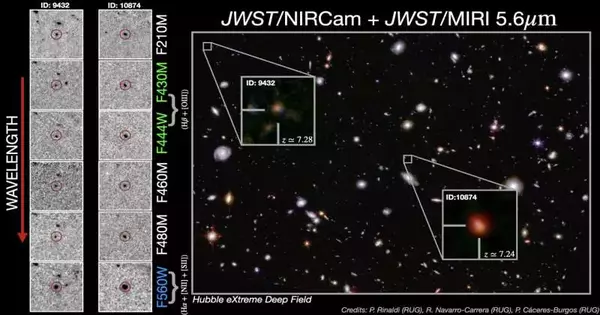H-alpha emission in individual galaxies during the so-called Epoch of Reionization, or cosmic dawn, has been discovered for the first time by an international team of astronomers led by Pierluigi Rinaldi of the University of Groningen. They used the James Webb Space Telescope’s MIRI instrument’s deepest images to accomplish this. The result is currently available on the arXiv preprint server and has been accepted for publication in The Astrophysical Journal.
UV photons are abundant in star-forming galaxies, but during the Epoch of Reionization, these photons are absorbed by the interstellar medium. The H-alpha emission line in the optical spectrum is the best tracer for determining the degree of star formation. This optical line shifts to longer wavelengths in the near and mid-infrared for galaxies with a high redshift.
With the MIRI instrument on JWST, the H-alpha line has been examined for the first time for galaxies with a redshift greater than seven (z>7) during the cosmic dawn, which occurred less than a billion years after the Big Bang and saw the ionization of neutral hydrogen gas. For the first time, the study by Rinaldi and colleagues demonstrates that JWST and MIRI can be used to study star formation in early galaxies in depth.
“This research opens up the possibility of studying early galaxies in ways that were not previously possible.” The best part is that we’ve demonstrated that this type of research can be done on a regular basis using JWST/MIRI.”
First author Pierluigi Rinaldi
The Epoch of Reionization’s galaxies are poorly understood. Previous research has relied on the analysis of Lyman-alpha, another prominent spectral line, at high redshifts. However, in the cosmic dawn, this line is absorbed by the intergalactic medium, which is mostly opaque at that time, making it either very faint or not present at all in galaxies. Astronomers can study the formation of stars in these early galaxies because H-alpha is unaffected by the opaque intergalactic medium.
One of the other four Webb instruments, NIRCam, is an important tool for this research. This study’s ultra-deep MIRI image was obtained within the MIRI European Guaranteed Time. In the Hubble Extreme Deep Field (XDF), ancillary HST data were also utilized by the researchers.
Based on their analysis of the more sensitive NIRCam images, the researchers first looked for star-forming galaxies that might have emission lines at the time of reionization. After that, they used MIRI to analyze images of these particular galaxies at longer wavelengths. They discovered that many of them are very bright at 5.6 microns, indicating that these sources contain a very prominent H-alpha emission line.
“This research opens up the possibility of studying early galaxies in a way that was not possible before,” states the study’s first author, Pierluigi Rinaldi. The good news is that we have demonstrated that this kind of research can be carried out frequently using JWST and MIRI.
Using JWST, the astronomers intend to observe galaxies in detail. The goal is to learn more about the shape of the emission lines from the galaxies, which may reveal more about the gas kinematics and star formation dynamics.
More information: P. Rinaldi et al, MIDIS: Strong (Hb + [OIII]) and Ha emitters at redshift z≃7−8 unveiled with JWST/NIRCam and MIRI imaging in the Hubble eXtreme Deep Field (XDF), arXiv (2023). DOI: 10.48550/arxiv.2301.10717





